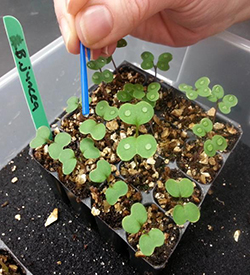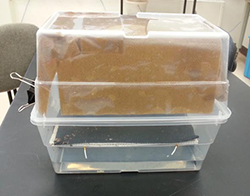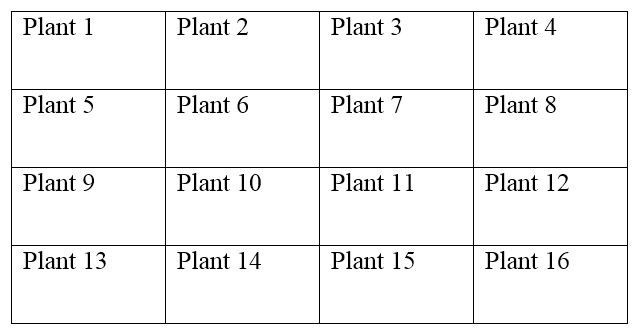Hayslett, Maya C. 2017. Investigating Resistance in a Population with Rapid-cycling
Brassica species and
Albugo candida.
The Plant Health Instructor. 10.1094/PHI-T-2017-0711-01
Maya C. Hayslett, Paul H. Williams, Douglas I. Rouse, and Victoria Kartanos, Department of Plant Pathology, University of Wisconsin – Madison
Objectives
The main objective is for students to describe resistance and susceptibility in a genetically variable population and consider the molecular mechanisms of these interactions. Because there is a range of interactions between pathogen and host being observed we introduce the term “interaction phenotypes” as a means of referring to them in aggregate. Specifically, students should be able to:
-
identify differences in interaction phenotype,
-
consider the different factors (single resistance genes, multigenic resistance, other interacting genes, and environment) that result in differences in interaction phenotype, and
-
use terms related to resistance correctly (complete/incomplete resistance, single/multigene resistance).
Click here for instructor note #1: Discussion of learning objectives
Introduction
Resistance is generally considered in plant pathology to be the “best” way to manage plant diseases (Hogenboom 1992). Host resistance to plant pathogens can be conferred by a single and usually dominant gene (monogenic or single-gene resistance) or by several genes (polygenic or multi-gene resistance). In this lab exercise students will look at resistance and susceptibility in a genetically diverse population and consider the different factors that affect disease expression.
Albugo candida is the causal agent of white rust of brassicas. This oomycete is found worldwide on cruciferous crops. It has several pathotypes with different interaction phenotypes on different
Brassica species and varieties. There are several known sources of resistance to the pathogen including both monogenic and multi-gene resistance (Saharan et al. 2014). We use
A. candida as an example of an oomycete disease in our introductory plant pathology course. White pustules full of sporangia are produced on the underside of leaves. Sporangia may germinate or form zoospores that subsequently encyst and germinate (Alexopoulos et al. 1996). Disease development is favored by cool and moist conditions and leaf wetness is required for infection (Koike and Subbarao 2008).
Rapid-cycling brassicas were developed as model organisms to study disease development within and between genetically diverse but defined populations (Williams and Hill 1986). The plants are small and grow quickly, allowing production of a large number of plants in a small space in a short period of time. We can grow and inoculate 70-100 plants to get a representative population sample to access the variation in interaction phenotypes that can occur in a genetically diverse population. Brassicas are also good hosts for
A. candida. In this system, inoculated plants can be rated for disease after seven days for quick results.
For this exercise students examine the interaction between
Albugo candida pathotype 2 and two
Brassica species,
B. rapa and
B. juncea. B. juncea is the susceptible host for pathotype 2 in this experiment and the population has no resistance to this pathogen. In the
B. rapa population, a single gene that confers resistance to pathotype 2 is present. As a class, students inoculate a genetically variable population of each species and rate disease the following week based on development of signs.
Materials
-
16 plants per group (a population of either
B. juncea or
B. rapa)
-
A. candida inoculum, 1 ml per 16 plants
-
Plastic cocktail straws for performing the inoculation
-
Moist chambers
Click here for instructor Note #2: Preparation of materials
Procedure
IMPORTANT: Moisture is extremely important for getting a successful infection. The goal is to place a drop of inoculum on a cotyledon and have it STAY THERE for several hours. So work quickly and immediately place the inoculated plants in the moist chamber.
-
Use a pot label to label your set of plants with the species and a group name
-
QUICKLY, use the straw to place a drop of inoculum on each lobe of each cotyledon of each plant. (two drops per cotyledon, four drops per plant) (Figure 1).
-
Return the plants QUICKLY to the covered chamber (Figure 2).
Plants are assessed for disease after 7 days.
 |
 |
Figure 1: Inoculation of cotyledons,
drops of inoculum are placed,
two on each cotyledon,
with a cocktail straw. |
Figure 2: After inoculation, plants are placed in a
moist chamber for incubation. In this case another
plastic tub lined with wet paper towels is inverted,
placed on top and sealed with clips. |
Observations and Questions for Students
Questions at the start of the experiment:
-
To prepare the inoculum, we start by incubating sporangia in water. What type of spore will you use to inoculate the plants?
-
Next week when you examine your plants, how will you know which ones are susceptible and which ones are resistant? What will they look like?
-
What do you expect to see in terms of susceptibility and resistance in the
B. juncea plants?
-
What do you expect to see in terms of susceptibility and resistance in the
B. rapa plants?
Data collection and questions at the end of the experiment:
Use the rating scale provided to assess disease on each plant. Check both top and bottom surfaces of the cotyledons for pustules.
Rating scale for assessing white rust on fast plant cotyledons (Figure 3):
0 = No symptoms
1 = Small, pinpoint, flecks. No sporulation. (hypersensitive response)
3 = Very sparse, one to a few, small scattered pustules on upper or lower surface
5 = Few to many scattered pustules on upper or lower surface
7 = Many scattered larger pustules on upper or lower surface
9 = Large, coalescing pustules on upper or lower surface
 |
|
Table 1. Experimental results can be recorded in the table shown. |
|
|
|
Figure 3: Rating scale for
Albugo candida, 0 = No symptoms, 1 = Small, pinpoint, flecks. No sporulation. (hypersensitive response), 3 = Very sparse, one to a few, small scattered pustules on upper or lower surface, 5 = Few to many scattered pustules on upper or lower surface, 7 = Many scattered larger pustules on upper or lower surface, 9 = Large, coalescing pustules on upper or lower surface. |
Species:
Average rating:
The class data will now be collected and analyzed.
Give a brief description of the ratio of interaction phenotypes for each species.
-
How do you explain the diversity of interactions seen in the
B. rapa?
-
It seems that there are different types of resistance at work. If you are a plant breeder, which type of resistance do you want to use for your crop breeding? Why? What are the advantages and disadvantages?
Example results in
Figure 4.
Click here for instructor Notes #3: Explanation of expected results.
|
|
Figure 4: A selection of
B. rapa (top) displaying disease ratings from 0 (complete resistance) to 9 (no resistance) based on sign development. Example ratings are given as numbers above the cotyledon. The four plants on the right would all be rated as 0 as they have no pustule development. |
Literature Cited
Alexopoulos, C. J., Mims, C. W., and Blackwell, M. 1996. Introductory Mycology. John Wiley and Sons, Inc., New York.
Hogenboom, N. G. 1993. Economic importance of breeding for disease resistance. Pages 5-9 in: Durability of Disease Resistance, Volume 18 of the series Current Plant Science and Biotechnology in Agriculture, Th. Jacobs and J. E. Parlevliet, eds. Springer Science+Business Media, Dordrecht.
Koike, S. T., and Subbarao, K. V. 2008. UC IPM: UC Management Guidelines for White Rust on Cole Crops. University of California Agriculture and Natural Resources, n.d. Web. 27 May 2016.
Saharan, G. S., Verma, P. R., Meena, P. D., and Kumar, A. 2014. White Rust of Crucifers: Biology, Ecology and Management. Springer India. New Delhi.
Williams, P. H., and Hill, C. B. 1986. Rapid-cycling populations of Brassica. Science. 232:1385-9.
